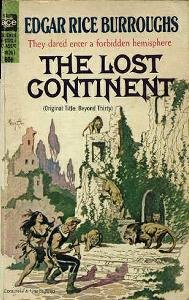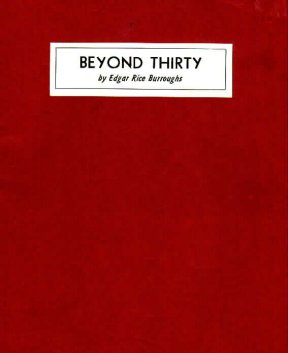
The First and Only Online Fanzine Devoted to the Life and Works of Edgar Rice Burroughs Master of Imaginative Fantasy Adventure Creator of Tarzan and "Grandfather of American Science Fiction" |

The First and Only Online Fanzine Devoted to the Life and Works of Edgar Rice Burroughs Master of Imaginative Fantasy Adventure Creator of Tarzan and "Grandfather of American Science Fiction" |
Bill Hillman's 
Weekly Online Fanzine

The Many Worlds of
"The master of imaginative fantasy adventure...
...the creator of Tarzan and...
...the 'grandfather of science-fiction'"
PART OF THE ERBzine COMPENDIUM:
ERB VISIONS OF THE FUTURE

The Lost Continent (Beyond Thirty)
ERB's View of the 22nd Century
a review by
Dale Robinson (Vandor)
Edgar Rice Burroughs’ The Lost Continent was probably the second story I ever read by the Master of Adventure. I picked up an Ace edition in the same used bookstore where I originally discovered ERB and began my first trip to Barsoom as John Carter challenged the gods of Mars. The Lost Continent was an odd-sized little paperback. The title caught my eye -- ahh, a story of Atlantis? Or maybe a lost world of dinosaurs or other monsters? No, even better -- a Day After Doomsday story!I quickly devoured the story of Lieutenant Jefferson Turck who faced a world turned upside down by war. It was standard Burroughs fare. Intrepid hero meets girl, saves girl, falls in love with girl, unknowingly insults girl who then spurns him, loses girl only to find her once more to save her from a fate worse than death. The stuff dreams are made of!
Originally published in 1915 as “Beyond Thirty,” the story reflects U.S.. sentiments at the time. The first “modern war” engulfed Europe following the assassination of Archduke Ferdinand. Americans were predominantly isolationist and could see no need to be drawn into a European war. In The Lost Continent, Burroughs jumps us ahead two hundred years to find that the isolationist view prevailed. All contact has been lost with the world existing east of the 30th meridian and west of the 175th meridian. The results of the war that raged there are unknown.
The year is 2137 and Lieutenant Jefferson Turck is the 21 year young commander of the aero-submarine Coldwater. Coldwater is clearly a technological marvel by early 20th century standards; even today, on the verge of the 21st century, its capabilities are outside the realm of our science. As the term aero-submarine implies, Coldwater is capable of cruising either above or below the seas. This is accomplished by anti-gravitational screens. While we might consider Coldwater with awe, in the time of Jefferson Turck, the vessel was nearly obsolete, in dire need of repairs, yet tasked with patrolling the 30th meridian from Iceland to the Azores.
Disaster strikes Coldwater when first the anti-gravitation screens fail, dooming the vessel to wallow upon the surface of the ocean, and then the engines fail, leaving the ship adrift. The wireless radio failed as well, meaning that Turck could not even summon help. It’s implied that the Coldwater’s second officer was responsible for some of the misfortunes and it was his perfidy that set our hero adrift in a small boat with three companions when the repaired Coldwater abandoned them at sea.
Turck and his companions make shore in forbidden England, knowing that survival at sea would be impossible. From this point the real adventures begin, typical Burroughs, complete with savages, wild beasts, a beautiful princess, and a hero wise in all things except the ways of the heart. As I said, typical Burroughs! An excellent read!
It is evident, however that this is early Burroughs -- the timeline in The Lost Continent was skewed. He makes a major blunder in his efforts to set the time for the story. He states that Jefferson Turck is 21 years old and born in 2116, which sets the story in 2137. He makes several references to “two hundred years” as the amount of time that has passed since the Americas isolated themselves from the warring factions in the rest of the world. In one instance, he states that the last contact was when Turck’s ancestor handed a copy of the edict of 1971 (the version at ERBMania says 1972) to a Chinese naval officer “two hundred and six years ago.”
This is where ERB skewed his timeline. Admiral Turck, Jefferson’s ancestor, would have met the Chinese in 1931 to hand him an edict that would not be written for another 41 years. This skewed timeline is a bit frustrating to the “future historians” among us, but if you are able to ignore ERB’s poor math skills, the story is still a good one!
In addition to tackling the perils of world war, Burroughs tackles slavery and racism as well. Turck falls into the hands of the Abyssinian Empire, a black empire that rules all of Africa, most of Europe, and the Arabian peninsula. The Abyssinians are a mighty power, although their technology is probably equivalent to mid to late nineteenth century Europe. Still, the white savages that populate Europe in Turck’s time are no match for the well organized, well-armed Abyssinians. The Abyssinians have taken the white Europeans as slaves and Turck, of course, is pressed into slavery.
Whites in slavery to the blacks received no better treatment than blacks received under the hands of white masters in the United States prior to the Civil War. Free whites were second class citizens in the Abyssinian Empire, considered to be a lower order. Turck found himself fortunate to attract the attention of an Abyssinian colonel, who took our hero as his personal slave. As the colonel’s slave, Turck was treated better than many of his fellow slaves, was not mistreated, and could nearly forget his status, but rankled when reminded that he was but a slave.
Burroughs put an interesting twist on racism and slavery by reversing in his story the order of things in the real world. Somewhere in there, I think, is Burroughs' attitude toward slavery and racism -- he abhorred those abominations.
Turck, as a slave, finds himself in the court of the Abyssinian Emperor, Menelek XIV. Menelek is portrayed as gross and cruel, perhaps once a great emperor, but now corrupted by his power. While serving his master, the Abyssinian colonel, Turck watches, powerless, as white slave women are offered to the emperor. In true Burroughs fashion, our heroine, Victory, Queen of England, turns up in the Abyssinian’s court and is to be the next addition to the emperor’s harem.
Without spoiling the story for those familiar with Burroughs, Turck rescues Victory, they are reunited, and our young lieutenant, certain that he would be court martialed and executed for violating the edict against crossing the 30th meridian, is hailed as a hero in Pan-America.
Typical Burroughs fare, an excellent story. I recommend it to long-time Burroughs fans and neophyte fans as well. Enjoy!

The Lost Continent Timeline
Edgar Rice Burroughs, in his effort to set the time period for this story, made several errors in his time line.
1914 Archduke Ferdinand assassinated in Sarejvo; The Great War begins. (Historical fact.)
1931 Diplomatic relations severed with eastern powers. My supposition! I believe that Jefferson Turck was confusing the severing of diplomatic relations with the delivery of the Edict of 1971 to the Chinese. It’s very likely that an Admiral Turck presided at both events, perhaps even the same Admiral Turck. Our Lieutenant Jefferson Turck states that he is descended
from a long line of seafarers. (Ace, pg. 10)1946 Last contact between the warring nations of the east and the west is lost. (The date is my supposition again, based on my supposition of the 1931 severing of diplomatic relations. The narrator states that “news of more or less doubtful authenticity filtered” from the east to the west for “fifteen years after the cessation of diplomatic relations.” (Ace, pg. 7)
1971 Edict of 1971 is issued; Jefferson Turck’s ancestor, Admiral Turck delivers the Edict of 1971 to a Chinese naval officer in the final act of isolationism. Commerce between the east and west is prohibited. (Ace, pg. 9) (Our narrator states that this happened 206 years ago, which would have been 1931.)
1972 The last sighting of an eastern power’s submarine (Q-138) is made when it fires torpedoes at a Brazilian merchant ship.
[Editor's Note: The original hardcover version of Beyond Thirty uses the dates 1921 and 1922 instead of the 1971 and 1972 used in The Lost Continent reprints.]2116 Jefferson Turck is born in Arizona. (Ace, pg. 10)2137 The adventures of The Lost Continent occur: the aero-submarine Coldwater experiences a series of disastrous malfunctions and is cast adrift; Lieutenant Jefferson Turck and three companions are abandoned at sea. Turck makes his way to England, Abyssinia, and China; commerce and communications between the hemispheres are re-opened.

![]() WebJed: Bill Hillman
WebJed: Bill Hillman![]()
BILL
& SUE-ON HILLMAN ECLECTIC STUDIO
Some ERB Images and Tarzan©
are Copyright ERB, Inc.- All Rights Reserved.
All Original Work Is Copyrighted
© 1999/2010 by Bill Hillman and/or Contributing Authors
No part of this web site
may be reproduced without expressed permission from the respective owners.